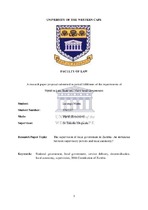| dc.contributor.advisor | Chigwata, Tinashe | |
| dc.contributor.author | Maina, Lutangu | |
| dc.date.accessioned | 2018-09-06T09:49:23Z | |
| dc.date.available | 2018-12-31T22:10:06Z | |
| dc.date.issued | 2018 | |
| dc.identifier.uri | http://hdl.handle.net/11394/6388 | |
| dc.description | Magister Legum - LLM (Public Law and Jurisprudence) | |
| dc.description.abstract | Since gaining independence in 1964, Zambia has embarked on a number of reforms,
including legislative, aimed at improving the effectiveness of its decentralised system of
government. Local government received constitutional recognition in 1996. In 2002, the
national government adopted the National Decentralisation Policy (NDP) which was
reviewed in 2013. The NDP established Ward Development Committees (WDCs) as the
lowest tier of government. It also defined the roles and responsibilities of local authorities,
provinces, and national government. The NDP aimed to address, among other things, the
problem of poor service delivery in Zambia that was partially attributed to a high
concentration of power at the centre. Despite these various legislative and policy reforms,
service delivery remained largely poor in many parts of Zambia. Local government still
failed to supply potable water, maintain roads, provide proper sanitation and collect refuse on
time, among other service delivery failures. | |
| dc.language.iso | en | |
| dc.publisher | University of the Western Cape | |
| dc.subject | National government, local government, service delivery, decentralisation,
local autonomy, supervision, 2016 Constitution of Zambia | |
| dc.title | The supervision of local government in Zambia: An imbalance
between supervisory powers and local autonomy? | |
| dc.rights.holder | University of the Western Cape | |

